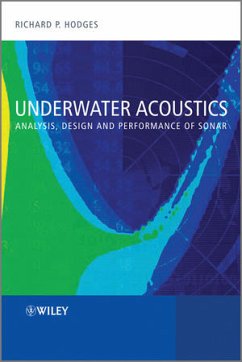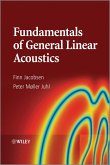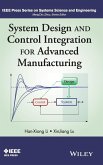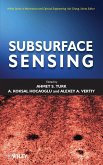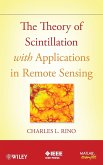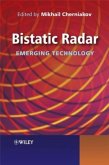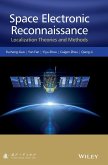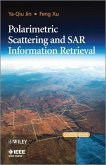- Gebundenes Buch
- Merkliste
- Auf die Merkliste
- Bewerten Bewerten
- Teilen
- Produkt teilen
- Produkterinnerung
- Produkterinnerung
Offering complete and comprehensive coverage of modern sonar spectrum system analysis, Underwater Acoustics: Analysis, Design and Performance of Sonar provides a state-of-the-art introduction to the subject and has been carefully structured to offer a much-needed update to the classic text by Urick. Expanded to included computational approaches to the topic, this book treads the line between the highly theoretical and mathematical texts and the more populist, non-mathematical books that characterize the existing literature in the field. The author compares and contrasts different techniques…mehr
Andere Kunden interessierten sich auch für
![Fundamentals of General Linear Acoustics Fundamentals of General Linear Acoustics]() Finn JacobsenFundamentals of General Linear Acoustics107,99 €
Finn JacobsenFundamentals of General Linear Acoustics107,99 €![System Design and Control Inte System Design and Control Inte]() Han-Xiong LiSystem Design and Control Inte111,99 €
Han-Xiong LiSystem Design and Control Inte111,99 €![Subsurface Sensing Subsurface Sensing]() Ahmet S TurkSubsurface Sensing211,99 €
Ahmet S TurkSubsurface Sensing211,99 €![Theory of Scintillation Theory of Scintillation]() Charles RinoTheory of Scintillation146,99 €
Charles RinoTheory of Scintillation146,99 €![Bistatic Radar Bistatic Radar]() Mikhail Cherniakov (ed.)Bistatic Radar212,99 €
Mikhail Cherniakov (ed.)Bistatic Radar212,99 €![Space Reconnaissance C Space Reconnaissance C]() Fucheng GuoSpace Reconnaissance C190,99 €
Fucheng GuoSpace Reconnaissance C190,99 €![Polarimetric Scattering and SAR Information Retrieval Polarimetric Scattering and SAR Information Retrieval]() Ya-Qiu JinPolarimetric Scattering and SAR Information Retrieval183,99 €
Ya-Qiu JinPolarimetric Scattering and SAR Information Retrieval183,99 €-
-
-
Offering complete and comprehensive coverage of modern sonar spectrum system analysis, Underwater Acoustics: Analysis, Design and Performance of Sonar provides a state-of-the-art introduction to the subject and has been carefully structured to offer a much-needed update to the classic text by Urick. Expanded to included computational approaches to the topic, this book treads the line between the highly theoretical and mathematical texts and the more populist, non-mathematical books that characterize the existing literature in the field. The author compares and contrasts different techniques for sonar design, analysis and performance prediction and includes key experimental and theoretical results, pointing the reader towards further detail with extensive references. Practitioners in the field of sonar design, analysis and performance prediction as well as graduate students and researchers will appreciate this new reference as an invaluable and timely contribution to the field. Chapters include the sonar equation, radiated, self and ambient noise, active sonar sources, transmission loss, reverberation, transducers, active target strength, statistical detection theory, false alarms, contacts and targets, variability and uncertainty, modelling detections and tactical decision aids, cumulative probability of detection, tracking target motion analysis and localization, and design and evaluation of sonars
Hinweis: Dieser Artikel kann nur an eine deutsche Lieferadresse ausgeliefert werden.
Hinweis: Dieser Artikel kann nur an eine deutsche Lieferadresse ausgeliefert werden.
Produktdetails
- Produktdetails
- Verlag: John Wiley & Sons / Wiley
- Seitenzahl: 384
- Erscheinungstermin: 19. Juli 2010
- Englisch
- Abmessung: 253mm x 177mm x 27mm
- Gewicht: 794g
- ISBN-13: 9780470688755
- ISBN-10: 0470688750
- Artikelnr.: 28708065
- Herstellerkennzeichnung
- Libri GmbH
- Europaallee 1
- 36244 Bad Hersfeld
- gpsr@libri.de
- Verlag: John Wiley & Sons / Wiley
- Seitenzahl: 384
- Erscheinungstermin: 19. Juli 2010
- Englisch
- Abmessung: 253mm x 177mm x 27mm
- Gewicht: 794g
- ISBN-13: 9780470688755
- ISBN-10: 0470688750
- Artikelnr.: 28708065
- Herstellerkennzeichnung
- Libri GmbH
- Europaallee 1
- 36244 Bad Hersfeld
- gpsr@libri.de
RICHARD P. HODGES has forty years experience in sonar, operations analysis, modeling, and the simulation of military systems. He is currently working for Sonalysts, Inc as a principal analyst, and is a member of the Acoustic Society of America. He has taught courses at the Naval Underwater Warfare Center (NUWC) and elsewhere in naval analysis of sonar, acoustics, TMA, tactics, weapons, damage and kill mechanisms, C4I, non-acoustic sensors, platform dynamics weapons, tactics and on the use of NUWC's SIM II Naval Engagement Simulation.
About the Author xiii
Preface xv
Acknowledgements xvii
1 Introduction to Sonar 1
1.1 Acoustic Waves 1
1.1.1 Compressions and Rarefactions 3
1.2 Speed of Propagation 4
1.3 Acoustic Wave Parameters 5
1.4 Doppler Shift 9
1.5 Intensity, SPL, and Decibels 10
1.6 Combining Acoustic Waves 11
1.7 Comparative Parameter for Sound in Water and Air 14
References 15
2 The Sonar Equations 17
2.1 Signal-to-Noise Ratio 17
2.2 Active Sonar Equation 18
2.3 Signal Excess 20
2.4 Figure of Merit 20
References 21
3 Transducers, Directionality, and Arrays 23
3.1 Transducer Response 25
3.2 Beam Pattern Response 25
3.3 Linear Arrays 27
3.3.1 Triplet Towed Array 33
3.3.2 Multiline Towed Arrays 33
3.4 Rectangular Planar Array 33
3.5 Amplitude Shading 37
3.6 Continuous Arrays 37
3.7 Volumetric Arrays 41
3.8 Product Theorem 44
3.9 Broadband Beam Patterns 45
3.10 Directivity and Array Gain 45
3.11 Noise Cross-Correlation between Hydrophones 47
3.12 Directivity of Line Arrays 49
3.13 Directivity of Area Arrays 51
3.14 Directivity of Volumetric Arrays 52
3.15 Difference Arrays 54
3.16 Multiplicative Arrays 57
3.17 Sparsely Populated Arrays 59
3.18 Adaptive Beamforming 60
References 62
4 Active Sonar Sources 63
4.1 Source Level 63
4.2 Cavitation 64
4.3 Near-Field Interactions 67
4.4 Explosive Sources 67
4.5 Physics of Shock Waves in Water 68
4.6 Bubble Pulses 72
4.7 Pros and Cons of Explosive Charges 73
4.8 Parametric Acoustic Sources 73
References 74
5 Transmission Loss 75
5.1 Sound Speed Profile in the Sea 76
5.2 Snell's Law and Transmission across an Interface 77
5.3 Reflection and Transmission Coefficients 79
5.4 Transmission through a Plate 82
5.5 Ray Tracing 84
5.6 Spreading Loss 91
5.7 Absorption of Sound in the Ocean 92
5.7.1 Mechanisms of Absorption 92
References 95
6 Transmission Loss: Interaction with Boundaries 97
6.1 Sea State, Wind Speed, and Wave Height 97
6.2 Pierson-Moskowitz Model for Fully Developed Seas 99
6.3 Sea Surface Interaction 101
6.3.1 Lloyd Mirror Interference 101
6.3.2 Loss Due to Interaction with the Surface 104
6.4 Bottom Loss 112
6.4.1 Simple Rayleigh Bottom Loss Model 113
6.4.2 U.S. Navy OAML Approved Models of Bottom Loss 113
6.4.3 Low-Frequency Bottom Loss (LFBL) Model: 50 to 1000 Hz 113
6.4.4 High-Frequency Bottom Loss (HFBL) Model 114
6.4.5 High-Frequency Environment Acoustic (HFEVA) Model 117
6.5 Leakage Out of a Duct, Low-Frequency Cutoff 117
6.6 Propagation Loss Model Descriptions 120
6.6.1 Ray Models 120
6.6.2 Normal Modes 121
6.6.3 Parabolic Equations 122
6.6.4 U.S. Navy Standard Models 123
References 125
7 Ambient Noise 127
7.1 Ambient Noise Models 127
7.2 Seismic Noise 128
7.3 Ocean Turbulence 130
7.4 Shipping Noise 131
7.5 Wave Noise 131
7.6 Thermal Noise 131
7.7 Rain Noise 131
7.8 Temporal Variability of Ambient Noise 133
7.9 Depth Effects on Noise 133
7.10 Directionality of Noise 133
7.11 Under Ice Noise 137
7.12 Spatial Coherence of Ambient Noise 138
References 140
8 Reverberation 143
8.1 Scattering, Backscattering Strength, and Target Strength 143
8.1.1 Surface and Bottom Scattering 143
8.1.2 Volume Scattering 152
8.1.3 Bottom Scattering 152
8.1.4 Reverberation Target Strength 153
8.1.5 Calculation of Reverberation for Use in the Sonar Equation 154
8.1.6 Volume Reverberation Level 156
8.2 Reverberation Frequency Spread and Doppler Gain Potential 157
8.2.1 Power Spectral Density of a CW Pulse 159
8.2.2 Environmental Frequency Spreading 161
8.2.3 Frequency Spreading Due to Transmitter and Receiver Motion 161
8.2.4 Frequency Spreading Due to Target 162
8.3 Important Observation with Respect to Reverberation 164
References 164
9 Active Target Strength 167
9.1 Target Strength Definition 167
9.2 Active Target Strength of a Large Sphere 169
9.3 Active Target Strength of a Very Small Sphere 170
9.4 Target Strengths of Simple Geometric Forms 173
9.5 Target Strength of Submarines 173
9.6 The TAP Model 174
9.7 Target Strength of Surface Ships 176
9.8 Target Strength of Mines and Torpedoes 176
9.9 Target Strength of Fish 178
References 181
10 Radiated Noise 183
10.1 General Characteristics of Ship Radiated Noise 183
10.2 Propeller Radiated Noise 184
10.3 Machinery Noise 186
10.4 Resonance Noise 187
10.5 Hydrodynamic Noise 187
10.6 Platform Quieting 189
10.7 Total Radiated Noise 189
Reference 192
11 Self Noise 193
11.1 Flow Noise 193
11.2 Turbulent Noise Coherence 198
11.3 Strumming Noise 199
References 199
12 Statistical Detection Theory 201
12.1 Introduction 201
12.2 Case 1: Signal Is Known Exactly 205
12.2.1 Observations on Case 1 210
12.3 Case 2: Signal Is White Gaussian Noise 210
12.3.1 Observations on Case 2 213
References 214
13 Methodology for Calculation of the Recognition Differential 215
13.1 Continuous Broadband Signals (PBB) 216
13.1.1 PBB Step 1: Theoretical Broadband Nrd 217
13.1.2 PBB Step 2: Correction for Noise Spectrum 217
13.1.3 PBB Step 3: Correction for Processor Implementation 220
13.1.4 PBB Step 4: Correction for Nonideal Signal Characteristics 226
13.1.5 PBB Step 5: Adjustment for Additional At-Sea Losses 227
13.2 Continuous Narrowband Signals (PNB) 227
13.2.1 PNB Step 1: Theoretical Narrowband Nrd 229
13.2.2 PNB Step 2: Correction for Noise Spectrum 230
13.2.3 PNB Step 3: Correction for Processor Implementation 233
13.2.4 PNB Step 4: Correction for Nonideal Signal Characteristics (Signal
Is Not a Perfect Sine Wave) 239
13.2.5 PNB Step 5: Adjustment for Additional At-Sea Losses 240
13.2.6 Nrd Calculation Example 241
13.3 Active Sonar 241
13.3.1 CW Active Pulse Active Step 1: Theoretical Nrd 242
13.3.2 Active Step 2: Correction for Noise Spectrum 253
13.3.3 Active Step 3: Correction for Processor Implementation 255
13.3.4 Active Step 4: Correction for Nonideal Signal Characteristics 257
13.3.5 Active Step 5: Adjustment for Additional At-Sea Losses 257
13.3.6 Nrd Calculation Examples 258
13.4 Aural Detection 258
13.5 Display Nomenclature 261
References 264
14 False Alarms, False Contacts, and False Targets 265
14.1 Sea Story 265
14.2 Failure to Detect 266
14.3 Detection Theory 266
14.3.1 Hypothesis Testing 266
14.3.2 Probability Density Function 267
14.3.3 Detection of Constant Level 268
14.4 False Alarm Probability Calculation 269
14.5 False/Nonthreat Contacts 271
14.6 False Targets 271
14.7 Summary and Conclusions 272
References 272
15 Variability and Uncertainty 273
15.1 Random Variability of a Sonar 276
15.2 Sources of Variability 276
References 281
16 Modeling Detection and Tactical Decision Aids 283
16.1 Figure of Merit Range or R50 % 283
16.2 Tactical Decision Aids 287
References 289
17 Cumulative Probability of Detection 291
17.1 Why is CPD Important? 291
17.2 Discrete Glimpse and Continuous Looking 291
17.3 Lambda-Sigma Jump Model 292
17.4 Nonjump Processes 293
17.5 What Are Appropriate Random Parameters? 293
17.6 Approximation Method for Computation of the Cumulative Probability of
Detection (CPD) 296
References 298
18 Tracking, Target Motion Analysis, and Localization 299
18.1 Bearing Trackers 299
18.1.1 Amplitude Difference Method 299
18.1.2 Phase Difference Method or Cross-Correlation Method 300
18.2 General Principle of Tracking and Bearing Measurement 301
18.3 Other Sources of Bearing Error for Area Arrays 303
18.4 Additional Sources of Errors for Line Arrays 305
18.5 Bottom Bounce 306
18.6 Manual versus Automatic Tracking 306
18.7 Localization and Target Motion Analysis 307
18.7.1 Localization 307
18.7.2 Wave Front Curvature Ranging (WFCR) 312
18.7.3 Multipath Ranging (MPR) 314
18.7.4 Depression/Elevation (D/E) Ranging 317
18.7.5 Triangulation Ranging 317
18.8 Bearings Only Methodologies 319
18.9 Four-Bearing TMA 319
18.10 Ekelund Ranging 321
18.11 Range and Bearing TMA 322
18.12 Other Bearings Only TMA Methodologies 323
18.13 Other TMA and Localization Schemes 324
References 324
19 Design and Evaluation of Sonars 325
19.1 Choice of Frequency and Size 325
19.2 Computational Requirements 327
19.2.1 Beamforming 328
19.3 Signal Processing after Beamformer 329
19.3.1 Detection 329
19.4 Active Pulse Choice 330
19.5 Monostatic, Bistatic, and Multistatic Active Sonars 332
19.6 Ambiguity Functions 334
19.7 Mine Hunting and Bottom Survey Sonars 334
19.8 Echo Sounding and Fishing Sonars 335
19.9 Navigation 336
19.10 Vehicle Location and At-Sea Rescue 336
19.11 Intercept Receivers 336
19.12 Communications 336
19.13 Marine Mammals and Active Sonar 337
References 337
A Fourier Transforms 339
A.1 Definitions 339
A.2 Parseval's Theorem and Plancherel's Theorem 340
A.3 Properties of Fourier Transforms 341
A.4 Localization or Uncertainty Property 341
B Analysis of Errors Associated with a Least Squares Methodology 343
Reference 346
Index 347
Preface xv
Acknowledgements xvii
1 Introduction to Sonar 1
1.1 Acoustic Waves 1
1.1.1 Compressions and Rarefactions 3
1.2 Speed of Propagation 4
1.3 Acoustic Wave Parameters 5
1.4 Doppler Shift 9
1.5 Intensity, SPL, and Decibels 10
1.6 Combining Acoustic Waves 11
1.7 Comparative Parameter for Sound in Water and Air 14
References 15
2 The Sonar Equations 17
2.1 Signal-to-Noise Ratio 17
2.2 Active Sonar Equation 18
2.3 Signal Excess 20
2.4 Figure of Merit 20
References 21
3 Transducers, Directionality, and Arrays 23
3.1 Transducer Response 25
3.2 Beam Pattern Response 25
3.3 Linear Arrays 27
3.3.1 Triplet Towed Array 33
3.3.2 Multiline Towed Arrays 33
3.4 Rectangular Planar Array 33
3.5 Amplitude Shading 37
3.6 Continuous Arrays 37
3.7 Volumetric Arrays 41
3.8 Product Theorem 44
3.9 Broadband Beam Patterns 45
3.10 Directivity and Array Gain 45
3.11 Noise Cross-Correlation between Hydrophones 47
3.12 Directivity of Line Arrays 49
3.13 Directivity of Area Arrays 51
3.14 Directivity of Volumetric Arrays 52
3.15 Difference Arrays 54
3.16 Multiplicative Arrays 57
3.17 Sparsely Populated Arrays 59
3.18 Adaptive Beamforming 60
References 62
4 Active Sonar Sources 63
4.1 Source Level 63
4.2 Cavitation 64
4.3 Near-Field Interactions 67
4.4 Explosive Sources 67
4.5 Physics of Shock Waves in Water 68
4.6 Bubble Pulses 72
4.7 Pros and Cons of Explosive Charges 73
4.8 Parametric Acoustic Sources 73
References 74
5 Transmission Loss 75
5.1 Sound Speed Profile in the Sea 76
5.2 Snell's Law and Transmission across an Interface 77
5.3 Reflection and Transmission Coefficients 79
5.4 Transmission through a Plate 82
5.5 Ray Tracing 84
5.6 Spreading Loss 91
5.7 Absorption of Sound in the Ocean 92
5.7.1 Mechanisms of Absorption 92
References 95
6 Transmission Loss: Interaction with Boundaries 97
6.1 Sea State, Wind Speed, and Wave Height 97
6.2 Pierson-Moskowitz Model for Fully Developed Seas 99
6.3 Sea Surface Interaction 101
6.3.1 Lloyd Mirror Interference 101
6.3.2 Loss Due to Interaction with the Surface 104
6.4 Bottom Loss 112
6.4.1 Simple Rayleigh Bottom Loss Model 113
6.4.2 U.S. Navy OAML Approved Models of Bottom Loss 113
6.4.3 Low-Frequency Bottom Loss (LFBL) Model: 50 to 1000 Hz 113
6.4.4 High-Frequency Bottom Loss (HFBL) Model 114
6.4.5 High-Frequency Environment Acoustic (HFEVA) Model 117
6.5 Leakage Out of a Duct, Low-Frequency Cutoff 117
6.6 Propagation Loss Model Descriptions 120
6.6.1 Ray Models 120
6.6.2 Normal Modes 121
6.6.3 Parabolic Equations 122
6.6.4 U.S. Navy Standard Models 123
References 125
7 Ambient Noise 127
7.1 Ambient Noise Models 127
7.2 Seismic Noise 128
7.3 Ocean Turbulence 130
7.4 Shipping Noise 131
7.5 Wave Noise 131
7.6 Thermal Noise 131
7.7 Rain Noise 131
7.8 Temporal Variability of Ambient Noise 133
7.9 Depth Effects on Noise 133
7.10 Directionality of Noise 133
7.11 Under Ice Noise 137
7.12 Spatial Coherence of Ambient Noise 138
References 140
8 Reverberation 143
8.1 Scattering, Backscattering Strength, and Target Strength 143
8.1.1 Surface and Bottom Scattering 143
8.1.2 Volume Scattering 152
8.1.3 Bottom Scattering 152
8.1.4 Reverberation Target Strength 153
8.1.5 Calculation of Reverberation for Use in the Sonar Equation 154
8.1.6 Volume Reverberation Level 156
8.2 Reverberation Frequency Spread and Doppler Gain Potential 157
8.2.1 Power Spectral Density of a CW Pulse 159
8.2.2 Environmental Frequency Spreading 161
8.2.3 Frequency Spreading Due to Transmitter and Receiver Motion 161
8.2.4 Frequency Spreading Due to Target 162
8.3 Important Observation with Respect to Reverberation 164
References 164
9 Active Target Strength 167
9.1 Target Strength Definition 167
9.2 Active Target Strength of a Large Sphere 169
9.3 Active Target Strength of a Very Small Sphere 170
9.4 Target Strengths of Simple Geometric Forms 173
9.5 Target Strength of Submarines 173
9.6 The TAP Model 174
9.7 Target Strength of Surface Ships 176
9.8 Target Strength of Mines and Torpedoes 176
9.9 Target Strength of Fish 178
References 181
10 Radiated Noise 183
10.1 General Characteristics of Ship Radiated Noise 183
10.2 Propeller Radiated Noise 184
10.3 Machinery Noise 186
10.4 Resonance Noise 187
10.5 Hydrodynamic Noise 187
10.6 Platform Quieting 189
10.7 Total Radiated Noise 189
Reference 192
11 Self Noise 193
11.1 Flow Noise 193
11.2 Turbulent Noise Coherence 198
11.3 Strumming Noise 199
References 199
12 Statistical Detection Theory 201
12.1 Introduction 201
12.2 Case 1: Signal Is Known Exactly 205
12.2.1 Observations on Case 1 210
12.3 Case 2: Signal Is White Gaussian Noise 210
12.3.1 Observations on Case 2 213
References 214
13 Methodology for Calculation of the Recognition Differential 215
13.1 Continuous Broadband Signals (PBB) 216
13.1.1 PBB Step 1: Theoretical Broadband Nrd 217
13.1.2 PBB Step 2: Correction for Noise Spectrum 217
13.1.3 PBB Step 3: Correction for Processor Implementation 220
13.1.4 PBB Step 4: Correction for Nonideal Signal Characteristics 226
13.1.5 PBB Step 5: Adjustment for Additional At-Sea Losses 227
13.2 Continuous Narrowband Signals (PNB) 227
13.2.1 PNB Step 1: Theoretical Narrowband Nrd 229
13.2.2 PNB Step 2: Correction for Noise Spectrum 230
13.2.3 PNB Step 3: Correction for Processor Implementation 233
13.2.4 PNB Step 4: Correction for Nonideal Signal Characteristics (Signal
Is Not a Perfect Sine Wave) 239
13.2.5 PNB Step 5: Adjustment for Additional At-Sea Losses 240
13.2.6 Nrd Calculation Example 241
13.3 Active Sonar 241
13.3.1 CW Active Pulse Active Step 1: Theoretical Nrd 242
13.3.2 Active Step 2: Correction for Noise Spectrum 253
13.3.3 Active Step 3: Correction for Processor Implementation 255
13.3.4 Active Step 4: Correction for Nonideal Signal Characteristics 257
13.3.5 Active Step 5: Adjustment for Additional At-Sea Losses 257
13.3.6 Nrd Calculation Examples 258
13.4 Aural Detection 258
13.5 Display Nomenclature 261
References 264
14 False Alarms, False Contacts, and False Targets 265
14.1 Sea Story 265
14.2 Failure to Detect 266
14.3 Detection Theory 266
14.3.1 Hypothesis Testing 266
14.3.2 Probability Density Function 267
14.3.3 Detection of Constant Level 268
14.4 False Alarm Probability Calculation 269
14.5 False/Nonthreat Contacts 271
14.6 False Targets 271
14.7 Summary and Conclusions 272
References 272
15 Variability and Uncertainty 273
15.1 Random Variability of a Sonar 276
15.2 Sources of Variability 276
References 281
16 Modeling Detection and Tactical Decision Aids 283
16.1 Figure of Merit Range or R50 % 283
16.2 Tactical Decision Aids 287
References 289
17 Cumulative Probability of Detection 291
17.1 Why is CPD Important? 291
17.2 Discrete Glimpse and Continuous Looking 291
17.3 Lambda-Sigma Jump Model 292
17.4 Nonjump Processes 293
17.5 What Are Appropriate Random Parameters? 293
17.6 Approximation Method for Computation of the Cumulative Probability of
Detection (CPD) 296
References 298
18 Tracking, Target Motion Analysis, and Localization 299
18.1 Bearing Trackers 299
18.1.1 Amplitude Difference Method 299
18.1.2 Phase Difference Method or Cross-Correlation Method 300
18.2 General Principle of Tracking and Bearing Measurement 301
18.3 Other Sources of Bearing Error for Area Arrays 303
18.4 Additional Sources of Errors for Line Arrays 305
18.5 Bottom Bounce 306
18.6 Manual versus Automatic Tracking 306
18.7 Localization and Target Motion Analysis 307
18.7.1 Localization 307
18.7.2 Wave Front Curvature Ranging (WFCR) 312
18.7.3 Multipath Ranging (MPR) 314
18.7.4 Depression/Elevation (D/E) Ranging 317
18.7.5 Triangulation Ranging 317
18.8 Bearings Only Methodologies 319
18.9 Four-Bearing TMA 319
18.10 Ekelund Ranging 321
18.11 Range and Bearing TMA 322
18.12 Other Bearings Only TMA Methodologies 323
18.13 Other TMA and Localization Schemes 324
References 324
19 Design and Evaluation of Sonars 325
19.1 Choice of Frequency and Size 325
19.2 Computational Requirements 327
19.2.1 Beamforming 328
19.3 Signal Processing after Beamformer 329
19.3.1 Detection 329
19.4 Active Pulse Choice 330
19.5 Monostatic, Bistatic, and Multistatic Active Sonars 332
19.6 Ambiguity Functions 334
19.7 Mine Hunting and Bottom Survey Sonars 334
19.8 Echo Sounding and Fishing Sonars 335
19.9 Navigation 336
19.10 Vehicle Location and At-Sea Rescue 336
19.11 Intercept Receivers 336
19.12 Communications 336
19.13 Marine Mammals and Active Sonar 337
References 337
A Fourier Transforms 339
A.1 Definitions 339
A.2 Parseval's Theorem and Plancherel's Theorem 340
A.3 Properties of Fourier Transforms 341
A.4 Localization or Uncertainty Property 341
B Analysis of Errors Associated with a Least Squares Methodology 343
Reference 346
Index 347
About the Author xiii
Preface xv
Acknowledgements xvii
1 Introduction to Sonar 1
1.1 Acoustic Waves 1
1.1.1 Compressions and Rarefactions 3
1.2 Speed of Propagation 4
1.3 Acoustic Wave Parameters 5
1.4 Doppler Shift 9
1.5 Intensity, SPL, and Decibels 10
1.6 Combining Acoustic Waves 11
1.7 Comparative Parameter for Sound in Water and Air 14
References 15
2 The Sonar Equations 17
2.1 Signal-to-Noise Ratio 17
2.2 Active Sonar Equation 18
2.3 Signal Excess 20
2.4 Figure of Merit 20
References 21
3 Transducers, Directionality, and Arrays 23
3.1 Transducer Response 25
3.2 Beam Pattern Response 25
3.3 Linear Arrays 27
3.3.1 Triplet Towed Array 33
3.3.2 Multiline Towed Arrays 33
3.4 Rectangular Planar Array 33
3.5 Amplitude Shading 37
3.6 Continuous Arrays 37
3.7 Volumetric Arrays 41
3.8 Product Theorem 44
3.9 Broadband Beam Patterns 45
3.10 Directivity and Array Gain 45
3.11 Noise Cross-Correlation between Hydrophones 47
3.12 Directivity of Line Arrays 49
3.13 Directivity of Area Arrays 51
3.14 Directivity of Volumetric Arrays 52
3.15 Difference Arrays 54
3.16 Multiplicative Arrays 57
3.17 Sparsely Populated Arrays 59
3.18 Adaptive Beamforming 60
References 62
4 Active Sonar Sources 63
4.1 Source Level 63
4.2 Cavitation 64
4.3 Near-Field Interactions 67
4.4 Explosive Sources 67
4.5 Physics of Shock Waves in Water 68
4.6 Bubble Pulses 72
4.7 Pros and Cons of Explosive Charges 73
4.8 Parametric Acoustic Sources 73
References 74
5 Transmission Loss 75
5.1 Sound Speed Profile in the Sea 76
5.2 Snell's Law and Transmission across an Interface 77
5.3 Reflection and Transmission Coefficients 79
5.4 Transmission through a Plate 82
5.5 Ray Tracing 84
5.6 Spreading Loss 91
5.7 Absorption of Sound in the Ocean 92
5.7.1 Mechanisms of Absorption 92
References 95
6 Transmission Loss: Interaction with Boundaries 97
6.1 Sea State, Wind Speed, and Wave Height 97
6.2 Pierson-Moskowitz Model for Fully Developed Seas 99
6.3 Sea Surface Interaction 101
6.3.1 Lloyd Mirror Interference 101
6.3.2 Loss Due to Interaction with the Surface 104
6.4 Bottom Loss 112
6.4.1 Simple Rayleigh Bottom Loss Model 113
6.4.2 U.S. Navy OAML Approved Models of Bottom Loss 113
6.4.3 Low-Frequency Bottom Loss (LFBL) Model: 50 to 1000 Hz 113
6.4.4 High-Frequency Bottom Loss (HFBL) Model 114
6.4.5 High-Frequency Environment Acoustic (HFEVA) Model 117
6.5 Leakage Out of a Duct, Low-Frequency Cutoff 117
6.6 Propagation Loss Model Descriptions 120
6.6.1 Ray Models 120
6.6.2 Normal Modes 121
6.6.3 Parabolic Equations 122
6.6.4 U.S. Navy Standard Models 123
References 125
7 Ambient Noise 127
7.1 Ambient Noise Models 127
7.2 Seismic Noise 128
7.3 Ocean Turbulence 130
7.4 Shipping Noise 131
7.5 Wave Noise 131
7.6 Thermal Noise 131
7.7 Rain Noise 131
7.8 Temporal Variability of Ambient Noise 133
7.9 Depth Effects on Noise 133
7.10 Directionality of Noise 133
7.11 Under Ice Noise 137
7.12 Spatial Coherence of Ambient Noise 138
References 140
8 Reverberation 143
8.1 Scattering, Backscattering Strength, and Target Strength 143
8.1.1 Surface and Bottom Scattering 143
8.1.2 Volume Scattering 152
8.1.3 Bottom Scattering 152
8.1.4 Reverberation Target Strength 153
8.1.5 Calculation of Reverberation for Use in the Sonar Equation 154
8.1.6 Volume Reverberation Level 156
8.2 Reverberation Frequency Spread and Doppler Gain Potential 157
8.2.1 Power Spectral Density of a CW Pulse 159
8.2.2 Environmental Frequency Spreading 161
8.2.3 Frequency Spreading Due to Transmitter and Receiver Motion 161
8.2.4 Frequency Spreading Due to Target 162
8.3 Important Observation with Respect to Reverberation 164
References 164
9 Active Target Strength 167
9.1 Target Strength Definition 167
9.2 Active Target Strength of a Large Sphere 169
9.3 Active Target Strength of a Very Small Sphere 170
9.4 Target Strengths of Simple Geometric Forms 173
9.5 Target Strength of Submarines 173
9.6 The TAP Model 174
9.7 Target Strength of Surface Ships 176
9.8 Target Strength of Mines and Torpedoes 176
9.9 Target Strength of Fish 178
References 181
10 Radiated Noise 183
10.1 General Characteristics of Ship Radiated Noise 183
10.2 Propeller Radiated Noise 184
10.3 Machinery Noise 186
10.4 Resonance Noise 187
10.5 Hydrodynamic Noise 187
10.6 Platform Quieting 189
10.7 Total Radiated Noise 189
Reference 192
11 Self Noise 193
11.1 Flow Noise 193
11.2 Turbulent Noise Coherence 198
11.3 Strumming Noise 199
References 199
12 Statistical Detection Theory 201
12.1 Introduction 201
12.2 Case 1: Signal Is Known Exactly 205
12.2.1 Observations on Case 1 210
12.3 Case 2: Signal Is White Gaussian Noise 210
12.3.1 Observations on Case 2 213
References 214
13 Methodology for Calculation of the Recognition Differential 215
13.1 Continuous Broadband Signals (PBB) 216
13.1.1 PBB Step 1: Theoretical Broadband Nrd 217
13.1.2 PBB Step 2: Correction for Noise Spectrum 217
13.1.3 PBB Step 3: Correction for Processor Implementation 220
13.1.4 PBB Step 4: Correction for Nonideal Signal Characteristics 226
13.1.5 PBB Step 5: Adjustment for Additional At-Sea Losses 227
13.2 Continuous Narrowband Signals (PNB) 227
13.2.1 PNB Step 1: Theoretical Narrowband Nrd 229
13.2.2 PNB Step 2: Correction for Noise Spectrum 230
13.2.3 PNB Step 3: Correction for Processor Implementation 233
13.2.4 PNB Step 4: Correction for Nonideal Signal Characteristics (Signal
Is Not a Perfect Sine Wave) 239
13.2.5 PNB Step 5: Adjustment for Additional At-Sea Losses 240
13.2.6 Nrd Calculation Example 241
13.3 Active Sonar 241
13.3.1 CW Active Pulse Active Step 1: Theoretical Nrd 242
13.3.2 Active Step 2: Correction for Noise Spectrum 253
13.3.3 Active Step 3: Correction for Processor Implementation 255
13.3.4 Active Step 4: Correction for Nonideal Signal Characteristics 257
13.3.5 Active Step 5: Adjustment for Additional At-Sea Losses 257
13.3.6 Nrd Calculation Examples 258
13.4 Aural Detection 258
13.5 Display Nomenclature 261
References 264
14 False Alarms, False Contacts, and False Targets 265
14.1 Sea Story 265
14.2 Failure to Detect 266
14.3 Detection Theory 266
14.3.1 Hypothesis Testing 266
14.3.2 Probability Density Function 267
14.3.3 Detection of Constant Level 268
14.4 False Alarm Probability Calculation 269
14.5 False/Nonthreat Contacts 271
14.6 False Targets 271
14.7 Summary and Conclusions 272
References 272
15 Variability and Uncertainty 273
15.1 Random Variability of a Sonar 276
15.2 Sources of Variability 276
References 281
16 Modeling Detection and Tactical Decision Aids 283
16.1 Figure of Merit Range or R50 % 283
16.2 Tactical Decision Aids 287
References 289
17 Cumulative Probability of Detection 291
17.1 Why is CPD Important? 291
17.2 Discrete Glimpse and Continuous Looking 291
17.3 Lambda-Sigma Jump Model 292
17.4 Nonjump Processes 293
17.5 What Are Appropriate Random Parameters? 293
17.6 Approximation Method for Computation of the Cumulative Probability of
Detection (CPD) 296
References 298
18 Tracking, Target Motion Analysis, and Localization 299
18.1 Bearing Trackers 299
18.1.1 Amplitude Difference Method 299
18.1.2 Phase Difference Method or Cross-Correlation Method 300
18.2 General Principle of Tracking and Bearing Measurement 301
18.3 Other Sources of Bearing Error for Area Arrays 303
18.4 Additional Sources of Errors for Line Arrays 305
18.5 Bottom Bounce 306
18.6 Manual versus Automatic Tracking 306
18.7 Localization and Target Motion Analysis 307
18.7.1 Localization 307
18.7.2 Wave Front Curvature Ranging (WFCR) 312
18.7.3 Multipath Ranging (MPR) 314
18.7.4 Depression/Elevation (D/E) Ranging 317
18.7.5 Triangulation Ranging 317
18.8 Bearings Only Methodologies 319
18.9 Four-Bearing TMA 319
18.10 Ekelund Ranging 321
18.11 Range and Bearing TMA 322
18.12 Other Bearings Only TMA Methodologies 323
18.13 Other TMA and Localization Schemes 324
References 324
19 Design and Evaluation of Sonars 325
19.1 Choice of Frequency and Size 325
19.2 Computational Requirements 327
19.2.1 Beamforming 328
19.3 Signal Processing after Beamformer 329
19.3.1 Detection 329
19.4 Active Pulse Choice 330
19.5 Monostatic, Bistatic, and Multistatic Active Sonars 332
19.6 Ambiguity Functions 334
19.7 Mine Hunting and Bottom Survey Sonars 334
19.8 Echo Sounding and Fishing Sonars 335
19.9 Navigation 336
19.10 Vehicle Location and At-Sea Rescue 336
19.11 Intercept Receivers 336
19.12 Communications 336
19.13 Marine Mammals and Active Sonar 337
References 337
A Fourier Transforms 339
A.1 Definitions 339
A.2 Parseval's Theorem and Plancherel's Theorem 340
A.3 Properties of Fourier Transforms 341
A.4 Localization or Uncertainty Property 341
B Analysis of Errors Associated with a Least Squares Methodology 343
Reference 346
Index 347
Preface xv
Acknowledgements xvii
1 Introduction to Sonar 1
1.1 Acoustic Waves 1
1.1.1 Compressions and Rarefactions 3
1.2 Speed of Propagation 4
1.3 Acoustic Wave Parameters 5
1.4 Doppler Shift 9
1.5 Intensity, SPL, and Decibels 10
1.6 Combining Acoustic Waves 11
1.7 Comparative Parameter for Sound in Water and Air 14
References 15
2 The Sonar Equations 17
2.1 Signal-to-Noise Ratio 17
2.2 Active Sonar Equation 18
2.3 Signal Excess 20
2.4 Figure of Merit 20
References 21
3 Transducers, Directionality, and Arrays 23
3.1 Transducer Response 25
3.2 Beam Pattern Response 25
3.3 Linear Arrays 27
3.3.1 Triplet Towed Array 33
3.3.2 Multiline Towed Arrays 33
3.4 Rectangular Planar Array 33
3.5 Amplitude Shading 37
3.6 Continuous Arrays 37
3.7 Volumetric Arrays 41
3.8 Product Theorem 44
3.9 Broadband Beam Patterns 45
3.10 Directivity and Array Gain 45
3.11 Noise Cross-Correlation between Hydrophones 47
3.12 Directivity of Line Arrays 49
3.13 Directivity of Area Arrays 51
3.14 Directivity of Volumetric Arrays 52
3.15 Difference Arrays 54
3.16 Multiplicative Arrays 57
3.17 Sparsely Populated Arrays 59
3.18 Adaptive Beamforming 60
References 62
4 Active Sonar Sources 63
4.1 Source Level 63
4.2 Cavitation 64
4.3 Near-Field Interactions 67
4.4 Explosive Sources 67
4.5 Physics of Shock Waves in Water 68
4.6 Bubble Pulses 72
4.7 Pros and Cons of Explosive Charges 73
4.8 Parametric Acoustic Sources 73
References 74
5 Transmission Loss 75
5.1 Sound Speed Profile in the Sea 76
5.2 Snell's Law and Transmission across an Interface 77
5.3 Reflection and Transmission Coefficients 79
5.4 Transmission through a Plate 82
5.5 Ray Tracing 84
5.6 Spreading Loss 91
5.7 Absorption of Sound in the Ocean 92
5.7.1 Mechanisms of Absorption 92
References 95
6 Transmission Loss: Interaction with Boundaries 97
6.1 Sea State, Wind Speed, and Wave Height 97
6.2 Pierson-Moskowitz Model for Fully Developed Seas 99
6.3 Sea Surface Interaction 101
6.3.1 Lloyd Mirror Interference 101
6.3.2 Loss Due to Interaction with the Surface 104
6.4 Bottom Loss 112
6.4.1 Simple Rayleigh Bottom Loss Model 113
6.4.2 U.S. Navy OAML Approved Models of Bottom Loss 113
6.4.3 Low-Frequency Bottom Loss (LFBL) Model: 50 to 1000 Hz 113
6.4.4 High-Frequency Bottom Loss (HFBL) Model 114
6.4.5 High-Frequency Environment Acoustic (HFEVA) Model 117
6.5 Leakage Out of a Duct, Low-Frequency Cutoff 117
6.6 Propagation Loss Model Descriptions 120
6.6.1 Ray Models 120
6.6.2 Normal Modes 121
6.6.3 Parabolic Equations 122
6.6.4 U.S. Navy Standard Models 123
References 125
7 Ambient Noise 127
7.1 Ambient Noise Models 127
7.2 Seismic Noise 128
7.3 Ocean Turbulence 130
7.4 Shipping Noise 131
7.5 Wave Noise 131
7.6 Thermal Noise 131
7.7 Rain Noise 131
7.8 Temporal Variability of Ambient Noise 133
7.9 Depth Effects on Noise 133
7.10 Directionality of Noise 133
7.11 Under Ice Noise 137
7.12 Spatial Coherence of Ambient Noise 138
References 140
8 Reverberation 143
8.1 Scattering, Backscattering Strength, and Target Strength 143
8.1.1 Surface and Bottom Scattering 143
8.1.2 Volume Scattering 152
8.1.3 Bottom Scattering 152
8.1.4 Reverberation Target Strength 153
8.1.5 Calculation of Reverberation for Use in the Sonar Equation 154
8.1.6 Volume Reverberation Level 156
8.2 Reverberation Frequency Spread and Doppler Gain Potential 157
8.2.1 Power Spectral Density of a CW Pulse 159
8.2.2 Environmental Frequency Spreading 161
8.2.3 Frequency Spreading Due to Transmitter and Receiver Motion 161
8.2.4 Frequency Spreading Due to Target 162
8.3 Important Observation with Respect to Reverberation 164
References 164
9 Active Target Strength 167
9.1 Target Strength Definition 167
9.2 Active Target Strength of a Large Sphere 169
9.3 Active Target Strength of a Very Small Sphere 170
9.4 Target Strengths of Simple Geometric Forms 173
9.5 Target Strength of Submarines 173
9.6 The TAP Model 174
9.7 Target Strength of Surface Ships 176
9.8 Target Strength of Mines and Torpedoes 176
9.9 Target Strength of Fish 178
References 181
10 Radiated Noise 183
10.1 General Characteristics of Ship Radiated Noise 183
10.2 Propeller Radiated Noise 184
10.3 Machinery Noise 186
10.4 Resonance Noise 187
10.5 Hydrodynamic Noise 187
10.6 Platform Quieting 189
10.7 Total Radiated Noise 189
Reference 192
11 Self Noise 193
11.1 Flow Noise 193
11.2 Turbulent Noise Coherence 198
11.3 Strumming Noise 199
References 199
12 Statistical Detection Theory 201
12.1 Introduction 201
12.2 Case 1: Signal Is Known Exactly 205
12.2.1 Observations on Case 1 210
12.3 Case 2: Signal Is White Gaussian Noise 210
12.3.1 Observations on Case 2 213
References 214
13 Methodology for Calculation of the Recognition Differential 215
13.1 Continuous Broadband Signals (PBB) 216
13.1.1 PBB Step 1: Theoretical Broadband Nrd 217
13.1.2 PBB Step 2: Correction for Noise Spectrum 217
13.1.3 PBB Step 3: Correction for Processor Implementation 220
13.1.4 PBB Step 4: Correction for Nonideal Signal Characteristics 226
13.1.5 PBB Step 5: Adjustment for Additional At-Sea Losses 227
13.2 Continuous Narrowband Signals (PNB) 227
13.2.1 PNB Step 1: Theoretical Narrowband Nrd 229
13.2.2 PNB Step 2: Correction for Noise Spectrum 230
13.2.3 PNB Step 3: Correction for Processor Implementation 233
13.2.4 PNB Step 4: Correction for Nonideal Signal Characteristics (Signal
Is Not a Perfect Sine Wave) 239
13.2.5 PNB Step 5: Adjustment for Additional At-Sea Losses 240
13.2.6 Nrd Calculation Example 241
13.3 Active Sonar 241
13.3.1 CW Active Pulse Active Step 1: Theoretical Nrd 242
13.3.2 Active Step 2: Correction for Noise Spectrum 253
13.3.3 Active Step 3: Correction for Processor Implementation 255
13.3.4 Active Step 4: Correction for Nonideal Signal Characteristics 257
13.3.5 Active Step 5: Adjustment for Additional At-Sea Losses 257
13.3.6 Nrd Calculation Examples 258
13.4 Aural Detection 258
13.5 Display Nomenclature 261
References 264
14 False Alarms, False Contacts, and False Targets 265
14.1 Sea Story 265
14.2 Failure to Detect 266
14.3 Detection Theory 266
14.3.1 Hypothesis Testing 266
14.3.2 Probability Density Function 267
14.3.3 Detection of Constant Level 268
14.4 False Alarm Probability Calculation 269
14.5 False/Nonthreat Contacts 271
14.6 False Targets 271
14.7 Summary and Conclusions 272
References 272
15 Variability and Uncertainty 273
15.1 Random Variability of a Sonar 276
15.2 Sources of Variability 276
References 281
16 Modeling Detection and Tactical Decision Aids 283
16.1 Figure of Merit Range or R50 % 283
16.2 Tactical Decision Aids 287
References 289
17 Cumulative Probability of Detection 291
17.1 Why is CPD Important? 291
17.2 Discrete Glimpse and Continuous Looking 291
17.3 Lambda-Sigma Jump Model 292
17.4 Nonjump Processes 293
17.5 What Are Appropriate Random Parameters? 293
17.6 Approximation Method for Computation of the Cumulative Probability of
Detection (CPD) 296
References 298
18 Tracking, Target Motion Analysis, and Localization 299
18.1 Bearing Trackers 299
18.1.1 Amplitude Difference Method 299
18.1.2 Phase Difference Method or Cross-Correlation Method 300
18.2 General Principle of Tracking and Bearing Measurement 301
18.3 Other Sources of Bearing Error for Area Arrays 303
18.4 Additional Sources of Errors for Line Arrays 305
18.5 Bottom Bounce 306
18.6 Manual versus Automatic Tracking 306
18.7 Localization and Target Motion Analysis 307
18.7.1 Localization 307
18.7.2 Wave Front Curvature Ranging (WFCR) 312
18.7.3 Multipath Ranging (MPR) 314
18.7.4 Depression/Elevation (D/E) Ranging 317
18.7.5 Triangulation Ranging 317
18.8 Bearings Only Methodologies 319
18.9 Four-Bearing TMA 319
18.10 Ekelund Ranging 321
18.11 Range and Bearing TMA 322
18.12 Other Bearings Only TMA Methodologies 323
18.13 Other TMA and Localization Schemes 324
References 324
19 Design and Evaluation of Sonars 325
19.1 Choice of Frequency and Size 325
19.2 Computational Requirements 327
19.2.1 Beamforming 328
19.3 Signal Processing after Beamformer 329
19.3.1 Detection 329
19.4 Active Pulse Choice 330
19.5 Monostatic, Bistatic, and Multistatic Active Sonars 332
19.6 Ambiguity Functions 334
19.7 Mine Hunting and Bottom Survey Sonars 334
19.8 Echo Sounding and Fishing Sonars 335
19.9 Navigation 336
19.10 Vehicle Location and At-Sea Rescue 336
19.11 Intercept Receivers 336
19.12 Communications 336
19.13 Marine Mammals and Active Sonar 337
References 337
A Fourier Transforms 339
A.1 Definitions 339
A.2 Parseval's Theorem and Plancherel's Theorem 340
A.3 Properties of Fourier Transforms 341
A.4 Localization or Uncertainty Property 341
B Analysis of Errors Associated with a Least Squares Methodology 343
Reference 346
Index 347

